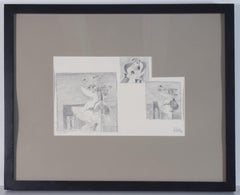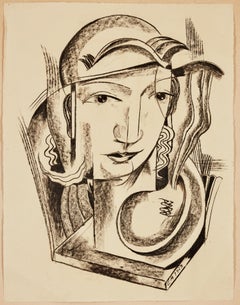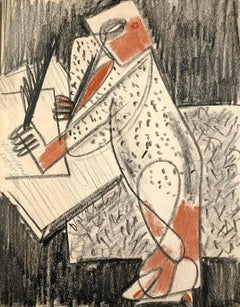Earl Horter Abstract Drawings and Watercolors
Earl Horter was born in 1881 in Germantown, Pennsylvania and was known for his realistic etchings and aquatints of urban scenes, though he was also an illustrator and painter. As a teenager, he engraved stock certificates. He was essentially self-taught, though he did take an etching class when he moved to New York City in 1903 to work for an advertising agency. Horter had a one-man show in 1916 in New York City at the Frederick Keppel and Company gallery. He was given the exhibition by Carl Zigrosser, later the first Curator of Prints and Drawings at the Museum of Modern Art. Horter was back in Philadelphia in 1917, where he would remain until his death in 1940. He worked there as an art director for the N. W. Ayer advertising firm from 1917–23. Horter was a member of the Society of Illustrators. He exhibited at the Pan American Exposition in 1915 in San Francisco, California; the Art Institute of Chicago, Illinois; and the Philadelphia Print Club's National Exhibition of Prints; as well as Corcoran Gallery biennials from 1935–39, in Washington, D.C. Horter is listed in Mantle Fielding's Dictionary of American Artists, Who Was Who in American Art and Mallett's Index of Artists. Though not a man of extraordinary means, Horter was a lover of modernist art, which he gradually purchased, creating an important collection, well ahead of its time in America, of Cubist and Precisionist works, as well as African sculpture and Native American artifacts. Horter collected include Europeans Picasso, Braque, Duchamp and Brancusi and Americans Charles Sheeler and Arthur B. Carles. He was a friend of Carles, as well as other artists and collectors such as Leopold Stokowski, conductor of the Philadelphia Orchestra; Franklin Watkins; S. S. White; and Carroll Tyson. Horter turned a Philadelphia brownstone into a studio and gallery to house his collection, aided by Paul Cret, the designer of the Barnes Foundation and Rodin Museum. By 1931, Horter would begin selling his collection due to financial need brought about by the Depression. Horter was also a teacher in Philadelphia at the Stella Elkins Tyler School of Art; Graphic Sketch Club (now the Fleisher Art Memorial); and the Philadelphia Museum School of Industrial Art (now the University of the Arts). In 1998, the Philadelphia Museum of Art put on an exhibition, “Mad for Modernism,” Horter and his collection, assembling once again many of the major works of art that comprised the artist's collection. In 1934, the Museum, then called the Pennsylvania Museum, had previously exhibited Horter's collection, though some of the works had already been sold. Several of Horter's prints are in the collection of Georgetown University, in Washington, D.C.
Early 20th Century Cubist Earl Horter Abstract Drawings and Watercolors
Paper, Pencil
1920s Cubist Earl Horter Abstract Drawings and Watercolors
Paper, Chalk
Mid-20th Century Cubist Earl Horter Abstract Drawings and Watercolors
Paper, Charcoal, Pastel
1970s Cubist Earl Horter Abstract Drawings and Watercolors
Color Pencil, Graphite
1940s Cubist Earl Horter Abstract Drawings and Watercolors
Paper, Graphite
20th Century Cubist Earl Horter Abstract Drawings and Watercolors
Paint, Etching, Lithograph
Mid-20th Century Cubist Earl Horter Abstract Drawings and Watercolors
Paper, Mixed Media
1940s Cubist Earl Horter Abstract Drawings and Watercolors
Paper, Graphite
21st Century and Contemporary Cubist Earl Horter Abstract Drawings and Watercolors
Paper, India Ink, Pen
20th Century Cubist Earl Horter Abstract Drawings and Watercolors
Paper, Acrylic
1910s Cubist Earl Horter Abstract Drawings and Watercolors
Paper, Watercolor
21st Century and Contemporary Cubist Earl Horter Abstract Drawings and Watercolors
Paper, Crayon, India Ink
21st Century and Contemporary Cubist Earl Horter Abstract Drawings and Watercolors
Paper, Oil Pastel


